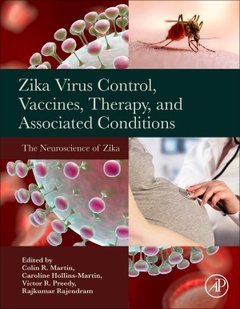Description
Zika Virus Impact, Diagnosis, Control, and Models
Volume 2: The Neuroscience of Zika Virus
Coordinators: R Martin Colin, Hollins-Martin Caroline, Preedy Victor R, Rajendram Rajkumar
Language: English
Subjects for Zika Virus Impact, Diagnosis, Control, and Models:
554 p. · 21.4x27.6 cm · Hardback
Description
/li>Contents
/li>Biography
/li>Comment
/li>
Zika Virus Impact, Diagnosis, Control, and Models: Volume Two: The Neuroscience of Zika examines diagnosis, vaccines, and potential therapy methods for Zika virus syndrome. The book also details the neuroscience of Guillain-Barré syndrome, its effects and neuromuscular rehabilitation. It is designed to help readers better understand detection, therapies for Zika virus, preventative vaccines, diagnosis and associated microcephaly. Chapters on models enable further research and understanding. This book has applicability for neuroscientists, neurologists, virologists and anyone working to better understand the evolution and pathogenesis of Zika virus-related conditions.
Section 1 – Methods, Biomarkers, and Diagnosis1. Imaging Zika virus infection2. Use of CRISPR: applications to flaviviruses3. Methods of investigating neurotoxicity of larvicides: applications of systems biology4. Methods for the detection of Zika virus infectivity
Section 2 – Vector Control, Vaccines, Pharmacology 5. Vector control and Zika virus: a focus on mosquitoes6. Vector control: a focus on rural household containers: applications to Zika virus7. Zika virus Vaccines: an overview8. Novel treatment with 2,8-bis(trifluoromethyl)quinoline analogs in Zika infection in vitro9. Zika virus use of human neutralizing antibody in microcephaly prevention: a modelling system10. Policies on Zika virus Control
Section 3 – Novel and Non-Pharmacologic Therapies11. Role of the pediatric neurologist in treating Zika virus syndrome12. 25-Hydroxycholesterol usage in Zika Virus Infection13. Screening and inhibition of the flavivirus NS2B-NS3 protease: application to zika virus14. Gene silencing and applications to zika virus15. Screening phytochemicals that react against Zika virus
Section 4 – Models and Modelling16. Guinea pig model of Zika virus: features and applications17. Rat model of Zika virus: features and applications18. Mouse model of Zika virus: features and applications19. Modelling Zika virus in the USA20. Modelling Zika virus infection in laboratory animals: impact on neurological systems
Section 5 – Neuroscience of Guillain-Barré Syndrome21. Severe Guillain-Barré Syndrome22. Plasmablasts, plasma and neurotoxic antibodies in Guillain-Barré syndrome23. Oxidative stress in Guillain-Barré Syndrome and linkage with neurology24. Neuromuscular effects and rehabilitation in Guillain-Barré syndrome25. Post-infectious demyelinating diseases: Guillain-Barré syndrome and beyond
Section 6 – Neuroscience of Microcephaly26. Microcephaly and developmental delays27. Congenital microcephaly: features and risk factors28. Microcephaly in fetal alcohol syndrome29. Microcephaly in genetic disorders: the case of MFSD2A and hypomyelination30. Folate metabolism, 5,10-methenyltetrahydrofolate synthetase and microcephaly
Section 7 – International Aspects31. Zika Virus in Honduras32. Zika Virus in Uganda33. Zika Virus in Jamaica34. Zika virus in Mozambique35. Zika virus in Brazil
Section 8 – Case Reports36. Case reports: Zika and Chikungunya virus infection37. Case reports: Zika virus neuroretinitis38. Case reports: Zika virus infection in Singapore39. Case reports: Coinfection with Zika virus and dengue-2 viruses40. Case report: Guillain-Barré and Zika virus infection
- Provides a broad range of topics related to the neuroscience of Zika, including its diagnosis, vaccines and therapy
- Contains chapter abstracts, key facts, a dictionary of terms and summary points to aid in understanding
- Discusses novel and non-pharmacological therapies, Guillain-Barré Syndrome and vaccine development
- Features chapters on rat, mouse, and guinea pig models of Zika and case reports of Zika co-infection with chikungunya, dengue-2 and Guillain-Barré
- Includes coverage of microcephaly and developmental delays and examines Zika outbreaks in Brazil, Honduras, Uganda, Jamaica and Mozambique
These books may interest you

The Neuroscience of Zika Virus 405.34 €



